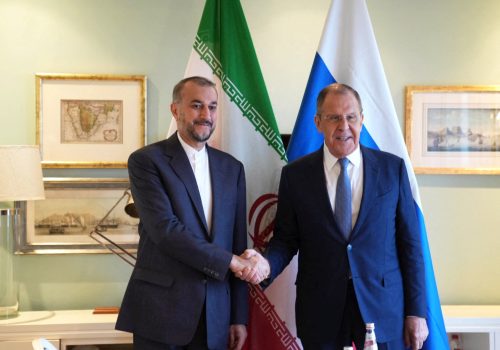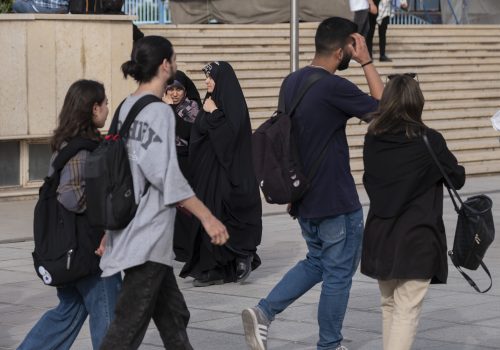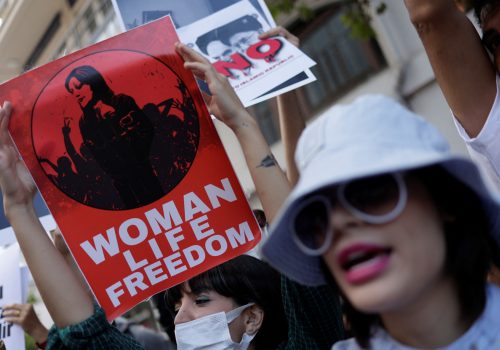The United States needs a new Iran policy—and it involves regime change, but not the traditional kind
Ever since the founding of the Islamic Republic in 1979, Iran’s leaders have believed that the United States seeks regime change to roll back the Islamic revolution and restore US hegemony in Iran. Yet the United States has not pursued this as a policy goal, nor has US policy appeared to include direct interference in Iran’s domestic affairs. Instead, in recent years, US policymakers seem to have assigned Iran—and the Middle East more broadly—a lower priority than other areas like Ukraine, and have pursued a policy of containment toward Iran so that US attention could be focused elsewhere.
This policy has clearly failed. The Islamic Republic has become increasingly confident in its international behavior and domestic repression, bolstered by the belief that the West—especially the United States—is too weak to stop it. The result is that Iran today is a significant threat to stability, peace, and human rights in the Middle East. The October 7, 2023, attack by Iran’s client Hamas on Israel and subsequent attacks on shipping by the Iran-backed Houthi rebels of Yemen underscore two important realities: first, the crucial importance of Middle Eastern stability to global affairs; second, a dire need for the United States to overhaul its Iran policy. If the United States does not change its approach to Iran, the Islamic Republic’s behavior and regional stability will only worsen.
The time is ripe for policy change. Despite harsh international sanctions, the clerical establishment has not moderated its behavior and flouts those sanctions, such as when it sells oil to China. Limited US engagement with Iran has also failed to rein in Tehran’s worst impulses. Despite the successful signing of the Joint Comprehensive Plan of Action (JCPOA), also known as the Iran nuclear deal, the unilateral US withdrawal from that agreement during the Donald Trump administration incentivized Iran to continue enriching uranium. The lack of consistency between US administrations makes a successful return to the negotiating table on nuclear issues unlikely. Meanwhile, Iran continues to engage in hostage diplomacy and flagrantly violates the human rights of its people. Its missile strikes against Iraq, Syria, and Pakistan on January 15 and January 16 also indicate the regime’s increasing willingness to use military force against its neighbors and project power outside its borders, which risks further destabilizing an already unstable region.
The world has changed since US policy on Iran was last set. An influential bloc of countries—led by Russia and China—has arisen to challenge the US-led international order. Iran has gained important allies by joining this bloc. Tehran’s growing partnerships with Moscow and Beijing provide it with diplomatic support, an economic lifeline, and increasing military prestige through its aid to Russia in the Ukraine war. Quite simply, the world today is far less united in its condemnation of Iran’s behavior—and its support for democracy, human rights, and the rule of law—than in previous decades. US policy must adapt to account for this geopolitical shift.
Yet Iran’s domestic situation has also changed dramatically in a way that could benefit US policy objectives. While Iran faced multiple waves of popular protest over the past two decades, the Woman, Life, Freedom uprising that began in September 2022 distinctly differs from earlier protests. While previous protests called for reform, many Iranians now declared that reforming the Islamic Republic is impossible. The current movement calls for nothing less than the end of the clerical establishment and the creation of a secular democracy. US policymakers should take note of this critical shift. Should a democratic Iran develop, it would solve most of the problems with Iran’s current behavior. A stable, democratic Iran would be greatly in the US national interest.
While the mass protests of 2022–2023 have died down, Iranian citizens, especially women, continue to defy the regime. The Iranian people are not likely to change their views on the theocracy, and the regime cannot survive in the long term in the face of such widespread domestic opposition. After four decades of an oppressive, corrupt, ineffective government, there is not much more for the Iranian people to lose but much to be gained by seeking radical change. However, the regime’s brutally violent crackdown on protesters and anyone who expresses the slightest hint of anti-regime sentiment indicates that mass protests alone will be insufficient to topple the government—the tactics of 1979 are not enough in the 2020s. Additional strategies are necessary, and international support will be critical to ensuring the success of any mass democratic movement in Iran.
SIGN UP FOR THE THIS WEEK IN THE MIDEAST NEWSLETTER
The United States should, therefore, develop a new policy aimed at supporting the Iranian people in changing their government system. This must not be a policy of regime change in the traditional sense. While the United States has historically had success in overtly or covertly overthrowing foreign governments—including ousting Iranian Prime Minister Mohammad Mosaddegh in 1953—it has been bad at managing the long-term consequences of such actions. The outcomes of the post-9/11 US wars in Afghanistan and Iraq are but the most recent examples.
Iranian history also proves that regime change cannot come from the outside. Any government imposed by a foreign power—or that even appears to be—will lack domestic legitimacy. Ever since Iran’s constitutional revolution in 1905–1911, ending foreign influence over Iran’s leaders has been a major reason why Iranians opposed—and toppled—previous governments, including the Pahlavi monarchy in 1979. Thus, any government that replaces the Islamic Republic must be understood by the Iranian people as entirely indigenous in origin. It can have foreign alliances, but cannot be installed by foreign intervention. The traditional US approach of using military intervention or a coup to accomplish regime change would irredeemably taint whichever government replaces the current theocracy.
Instead of traditional regime change, the United States should adopt a two-pronged approach to assist the Iranian people in their pursuit of democratic change. In the short term, US policymakers should continue to engage in difficult diplomacy and deterrence with the Islamic Republic to try to reduce Iran’s bad behavior as much as possible, while keeping in mind that genuine détente with the regime is not possible given its ideology, in which anti-Americanism is a core element.
In the long term, the United States should implement a policy of overtly and covertly helping the Iranian people create the conditions to build and sustain a successful mass movement to democratize Iran and align its behavior with global norms and the rule of law, especially regarding human rights. To achieve this long-term goal, US policymakers must resist the urge to take the lead; they must instead listen to anti-regime Iranians in the country, especially experienced women’s rights activists, and dissidents in exile, and help the Iranian people empower themselves to lead the change in their country.
Such a policy approach is rare in US history. Yet there are precedents when Americans supported positive change abroad by adopting a supportive role and genuine commitment to democracy and human rights that successfully secured US objectives and international security. Rather than direct intervention, subtle forms of US support for anti-communist movements in Eastern Europe during the late Cold War, especially the Solidarity Movement in Poland, helped those movements ultimately overthrow their communist governments on their own, build nascent democratic systems, and end the Cold War in 1989–1991. While the US government hesitated for decades to condemn the South African apartheid regime, the US public’s vocal support for the anti-apartheid movement and active participation in divestment helped the South African people end racial apartheid and build an inclusive democratic government led by Nelson Mandela in 1994. Updating these approaches for the twenty-first century could go a long way toward helping Iranians build an Iran that is no longer a threat to its own people or regional stability.
US policymakers could deploy various tools on multiple fronts to accomplish this objective, and the United States would need to do this in partnership with its democratic allies. Countries with no problematic history of dominating Iran—such as Ireland, South Africa, Mauritius, New Zealand, or Japan—would be best suited to this work. In essence, dissident Iranians need space, resources, meaningful international support, and a measure of protection to organize a powerful opposition movement. US policy would serve to support these suppressed voices in Iran.
To implement this policy, the United States would work covertly with Iranians and overtly to marshal international support for the Iranian people. In Iran, US policymakers should identify as many key in-country individuals with whom to work as possible. Ideally, these should be people with local or national influence who can get things done, show leadership potential, bring diverse perspectives to the table, and have clear ideas for what a post-Islamic Republic Iran should look like. Iran’s prisons are full of such leaders; many more are emerging across the country. The United States would work with this cohort to help create and run workshops for Iranians on democratic capacity building, strategic planning, governance best practices, and help with ideas for economic support for movement participants, as well as connect these Iranians with activists abroad with relevant experience. The United States should also find a way to provide reliable, safe internet access that is not easy for the regime to hack or trace, which will be essential for movement organizing and education efforts.
Along the way, US policymakers must resist the urge to anoint a particular opposition leader, avoiding another Ahmed Chalabi situation. The Iranian people will choose their leaders in a post-Islamic Republic future, which is as it should be.
The United States could, however, attempt to unify the Iranian diaspora. The unprecedented coming together of the diaspora in support of the Woman, Life, Freedom movement provided protesters on the ground with much-needed moral support and international amplification of their voices. When the coalition of diasporic leaders collapsed by late spring 2023, it was a major blow to the movement on the ground in Iran. Building solidarity and unity within the long-factionalized diaspora will be difficult. Still, a unified diasporic voice—and funding—supporting the opposition movement in Iran will be a key component in such a movement’s ultimate success.
At the international level, the United States and its allies must keep the world’s attention on Iran. There is already significant support for Iranians among the global public, as evidenced by the many worldwide solidarity protests during the Woman, Life, Freedom movement. Governments must align with this global public opinion. Just as the United States and its allies did with the Soviet Union during the Cold War, the international community must consistently and loudly condemn all human rights violations and political repression by the Islamic Republic. International condemnation of Iran’s behavior through unified statements by a coalition of anti-regime—preferably, democratic—governments, as well as unified rejection of Iran holding influential human rights-related positions in the United Nations or its representation at legitimizing international forums like the World Economic Forum in Davos, would help maintain international pressure on the Islamic Republic.
The regime is not immune to global pressure to moderate its behavior. US policymakers could also do much to encourage enhanced US public support for the people of Iran. International media, US policymakers, and democratic allies can use knowledge and truth as weapons; the Islamic Republic relies on lies and deception. Shining a harsh light on those lies and countering them with truth will be a valuable approach to combatting autocracy and oppression. Propaganda efforts to drive a wedge between Russia and Iran, as well as undermine its support by the rank-and-file within the Islamic Revolutionary Guard Corps (IRGC) and military, would also help weaken the regime.
If, as President Joe Biden has insisted, the greatest global challenge today is the war between autocracy and democracy, then Iran is a major front in that war. The Woman, Life, Freedom uprising is the most consequential mass democratic movement in the world today. Supporting the growth, maturation, and ultimate success of this movement is not only morally right, but a strategically logical position for the United States to take. This policy will require years of commitment and a redefinition of what regime change policy looks like, but helping the Iranian people end the Islamic Republic’s bad behavior would be a major victory for democracy, human rights, and, ultimately, global stability. Iranians have the will and capacity to create a brighter future. Will US policymakers choose to help?
Dr. Kelly J. Shannon is a 2023–2024 W. Glenn Campbell and Rita Ricardo-Campbell national fellow at the Hoover Institution at Stanford University and associate professor of history at Florida Atlantic University.
Further reading
Thu, Aug 24, 2023
This is how Iranian history shapes the Islamic Republic’s relationship with the world
IranSource By
Iranians have a long historical memory, and Iran’s foreign policy is shaped in many ways by the nation’s history.
Fri, Sep 8, 2023
Iran will never go back to the way it was
IranSource By Holly Dagres
While some argue that the ongoing anti-establishment protests began in mid-September 2022, the reality is that Iranians have been defying the regime for years.
Thu, Sep 7, 2023
The protests in Iran are not a revolution—yet. These events must occur first.
IranSource By
To draw in the majority of Iranians, the protests in Iran need to have a leader or organization that people trust.
Image: Protestors release smoke in Iran's colors during a protest against the Islamic regime in Iran marking the 45th anniversary of the revolution, Washington, DC, February 10, 2024. The event comes amid rising tensions between Iran and the United States following the October 7, 2024, Hamas attacks in Israel, and amid the continuing Woman, Life, Freedom Movement that began with the death of Zhina Mahsa Amino in September, 2022. (Photo by Allison Bailey/NurPhoto)


